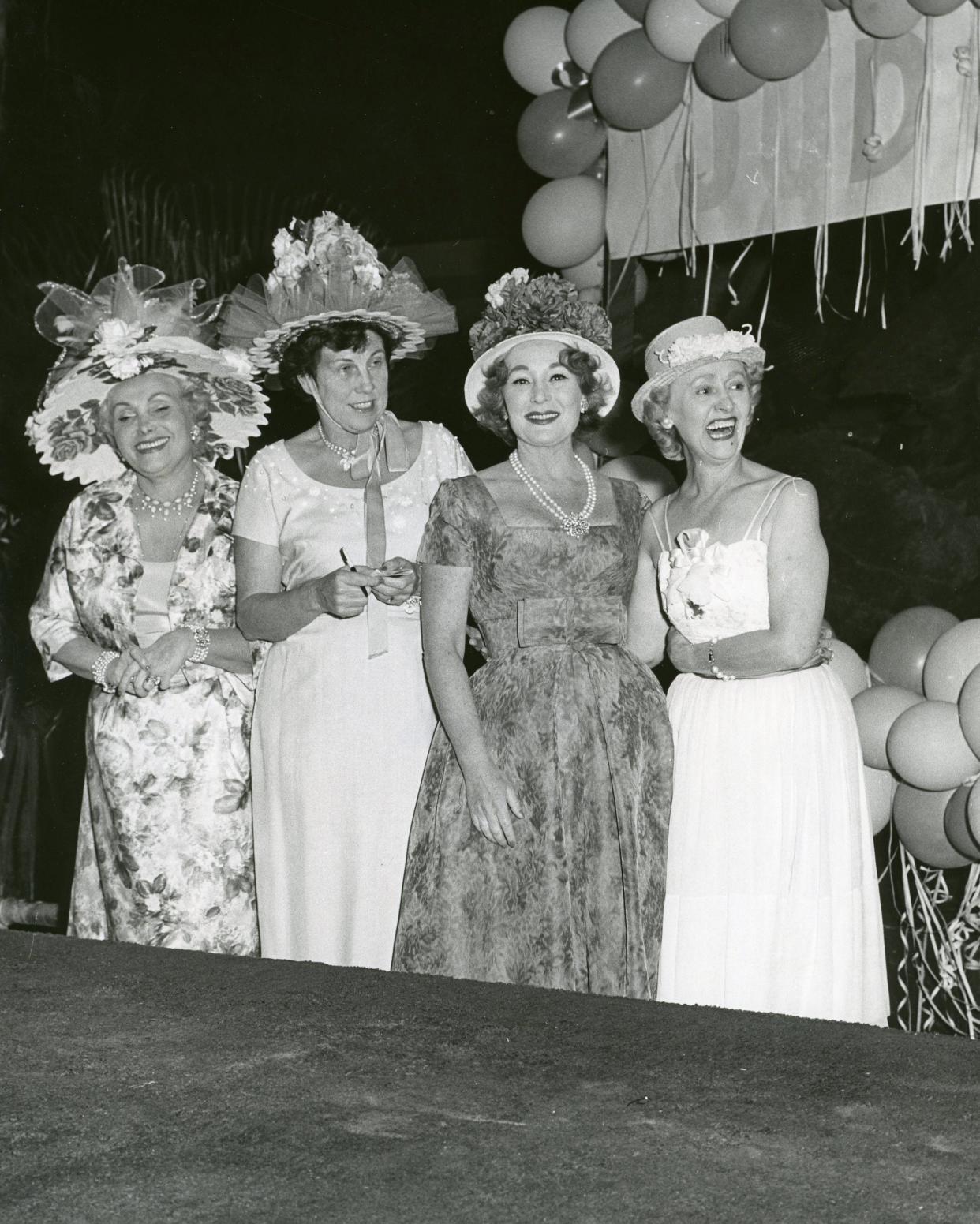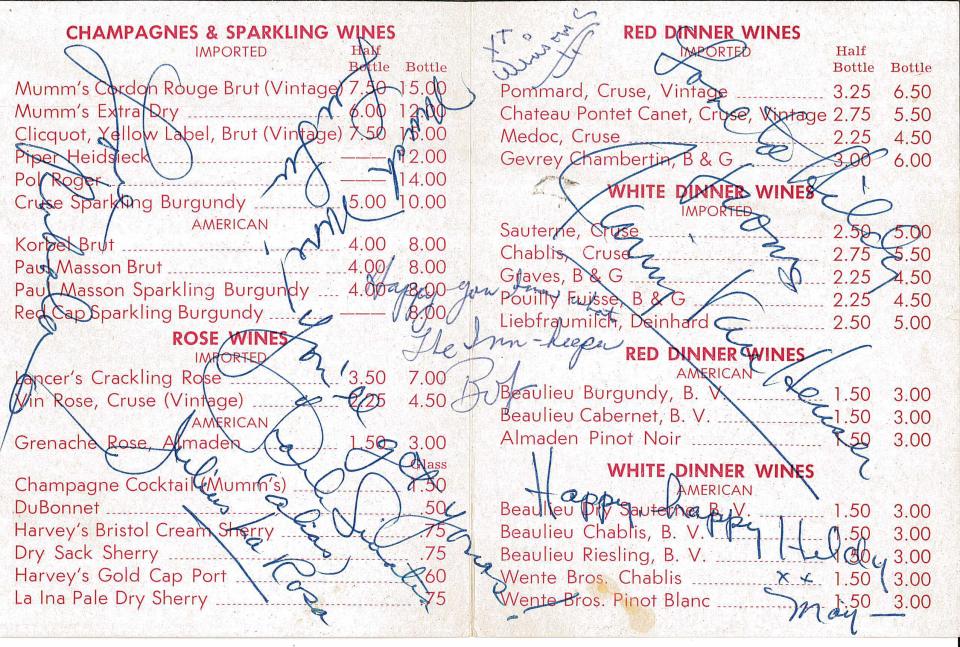History: Columnists chronicled society and celebrity in the desert

Scrawled across the Ruby’s Dunes Wine Menu, over the listing of imported champagnes and various available table wines, were well-wishes for Hildy Crawford’s birthday.
In gorgeous and bold cursive, the congratulations were signed by movie star-singer Frank Sinatra, composer extraordinaire Jimmy Van Heusen, and restaurant owner Irwin “Ruby” Rubinstein. Famous and charming, all three were regulars in Crawford’s newspaper columns and signed the menu as a memento of the occasion.
At the time of her birthday celebration Crawford was the reigning queen of the social circuit and the social pages in the desert in the mid-century.
The notion of newspaper and magazine society pages, the precursor to today’s social media, had started decades before with The Social Register. Mere wealth or fame were insufficient reasons for inclusion in The Social Register. (Later permutations were also known as the Blue Book, not just for the color of the binding but presumably for the color of the blood of those included in its pages.)
The publication began in the late 19th century as a list of the most prominent, wealthy, educated people of the robber baron class of the Gilded Age in New York, where everybody knew everybody in the upper echelon of society. By the 20th century, there were whole sections of newspapers and magazines nationwide devoted to reporting the activities and whereabouts of the privileged class. Those sections proved exceptionally popular.
An epigram written by Thomas Jefferson originally graced the frontispiece of The Social Register, “Let us in education dream of an aristocracy of achievement arising out of a democracy of opportunity.” His notion of that sort of meritocracy has been replaced by a “cult of celebrity” as famously noted by novelist Tom Wolfe.
In the desert, social standing, high society and celebrity would first collide in the mid-century. Previously, the elite “old money” crowd and Hollywood movie stars comfortably shared the few restaurants, bars and hotels that existed. Class stratification was blurred and even mostly ignored in the sunny informality of the desert. Palm Springs Mayor Frank Bogert once explained that the town was so small, everyone knew everyone, and everyone was invited to everything, in order to have any sort of satisfactory party.
And everyone easily conversed with, and confided in, Hildy Crawford, the society editor for The Desert Sun. That easy conversation and the presence of both celebrities and captains of industry gave Crawford “scoops” that other national columnists like Hedda Hopper and Louella Parsons would envy.
For 10 years starting in 1951 Crawford was the “Women’s Editor” for The Desert Sun and she spent three years writing for Palm Springs Life magazine. Starting in 1960 she began a little publication of prominent citizens, its own miniature social register of the desert, called “Personages” but informally dubbed the “Gold Book.”
Crawford was a trustee of Pathfinders and second vice-regent of Daughters of the American Revolution, Cahuilla chapter. Her husband Bill Crawford was an ex-Navy man and retired teacher who was associated with real estate agents Tony Burke and Culver Nichols, Palm Springs pioneers. But most importantly, Crawford was synonymous with the “Hat Parade” of Desert Circus Week and was the head of the event for nine years.
The Hat Parade was the desert’s premiere philanthropic happening. Interest in social status and socialites then was actually helpful to society in general, (instead of the prurient and voyeuristic tendency of social media today.) For good causes, fine ladies would don zany hats in good clean fun. Crawford admonished participants not to waste money buying chapeaux. “We want every cent possible to go to (charity). It’s fun to work your head off if you have nothing to spend but imagination and ingenuity.”

Allene Arthur, who would follow in Crawford’s footsteps, noted that before Crawford, “a married woman seldom had her first name appear in print. She was Mrs. John Fussyfeathers, never Mary Fussyfeathers.” Crawford democratized her reports, including everyone and earning friends everywhere. She herself became famous portraying “the social picture during the years after Hollywood annexed the desert but before there was a country club on every corner.”
Crawford had taken up cataloguing the comings and goings of “polite society” after her predecessor in the Limelight News. Arthur recalled, “Living quietly in a Palm Springs home nuzzled by citrus trees is the desert’s very first social columnist. Marj Pohl has probably written more about carloads of hors d’oeuvres, oceans of champagne and throngs of celebrities than the rest of us put together. In the late 1930s young Marj went to work for the Palm Springs Limelight weekly. They got their money’s worth. She reported the news, wrote her column and sold advertising.”
In addition, Pohl freelanced for The Desert Sun for 22 years, recalling, “In order to make a living here then, it was necessary to have umpteen jobs.” She publicized the Desert Inn for room, board and $50 a month. For 20 years she did much the same for the Racquet Club.
Arthur admired how Pohl “walked that delicate tightrope between letting the world know international figures were hanging out there while at the same time protecting their privacy.”
Pohl recalled years later that she eschewed pure scandal; for instance, “never reported that Howard Hughes owned five houses here with a different starlet stashed in each one.” Pohl deftly avoided her own scandal. “Having kept her same byline after marrying Dr. Robert White, she got tired of explaining the man she slept with was her husband. So she became Marj Pohl White.”
The role of social columnists has diminished as it has become widely disseminated. Chronicling social gatherings for philanthropic purposes has been largely supplanted by the shenanigans of celebrities being reported as news. Lamenting that he no longer heard regular reference to The Social Register, Wolfe opined that the "world of social luster has been so overshadowed by celebrities that it doesn’t have any kick anymore.” Twenty years on from that observation, the is no luster at all.
After their stint on the desert, the Crawfords sold the “Gold Book” and moved to Fern Valley in Idyllwild for a quieter life, away from high society and social whirlwind of Palm Springs. Back when, the entire valley was considered Palm Springs. Now there are nine cities with their own personalities and a profusion of charitable causes, making knowing everyone socially impossible.
Tracy Conrad is president of the Palm Springs Historical Society. The Thanks for the Memories column appears Sundays in The Desert Sun. Write to her at pshstracy@gmail.com.
This article originally appeared on Palm Springs Desert Sun: Columnists chronicled society and celebrity in the desert

